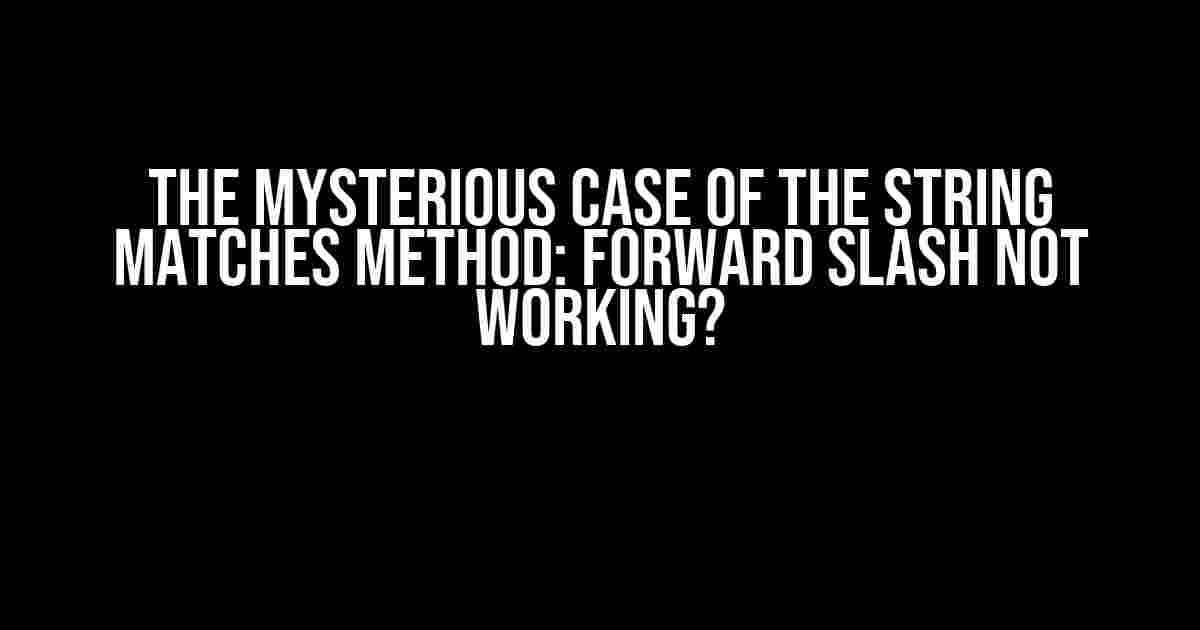Are you pulling your hair out trying to figure out why the string matches method isn’t working with forward slashes? You’re not alone! In this article, we’ll delve into the world of regular expressions and uncover the secrets behind this pesky problem.
What is the String Matches Method?
The string matches method, also known as the `matches()` method, is a powerful tool in programming languages like Java, JavaScript, and Python. It allows you to search for patterns within a string using regular expressions. Think of it like a superpowered “find and replace” feature!
Regular Expressions 101
Before we dive into the issue at hand, let’s quickly cover the basics of regular expressions. A regular expression, or regex, is a pattern used to match characters in a string. It’s like a recipe for finding specific sequences of characters.
// Example regex pattern: /hello/
In the example above, the regex pattern `/hello/` will match the exact string “hello” in a given input.
The Forward Slash Conundrum
Now, let’s talk about the forward slash (/) and why it’s causing issues in our string matches method. In regex, the forward slash is a special character that denotes the start and end of a pattern. However, when we try to match a forward slash within a string, things get hairy.
// Example: trying to match a forward slash in a string
const searchString = "https://example.com";
const regexPattern = /\/example\/;/;
console.log(searchString.matches(regexPattern)); // returns false
Why didn’t our regex pattern work? It’s because the forward slash is being treated as a delimiter, not as a character to be matched.
Escaping the Forward Slash
The solution to this problem is to escape the forward slash using a backslash (\) character. Think of the backslash as a ” shield” that protects the forward slash from being interpreted as a delimiter.
// Example: escaping the forward slash
const searchString = "https://example.com";
const regexPattern = /\:\/\/example\/;/;
console.log(searchString.matches(regexPattern)); // returns true
By adding the backslash, we’re telling the regex engine to treat the forward slash as a literal character, rather than a delimiter.
Other Special Characters to Watch Out For
The forward slash is just one of many special characters in regex that need to be escaped. Here are some other common culprits:
.(period) – matches any character\*(asterisk) – matches zero or more occurrences+(plus sign) – matches one or more occurrences?(question mark) – matches zero or one occurrence{}(curly braces) – matches a specific number of occurrences[](square brackets) – matches a character class()(parentheses) – groups characters and captures matches
When working with regex, it’s essential to be aware of these special characters and escape them accordingly.
Best Practices for Working with Regex
To avoid common pitfalls and ensure your regex patterns work as intended, follow these best practices:
- Use a regex tester tool: Websites like Regex101 or Regexr allow you to test and refine your regex patterns in real-time.
- Escape special characters: Remember to escape special characters using a backslash (\) to avoid unintended matches.
- Use character classes: Character classes (e.g., [a-z]) simplify your regex patterns and make them more readable.
- Group characters correctly: Use parentheses to group characters and capture matches, making it easier to extract specific parts of the input string.
- Test with different inputs: Verify that your regex pattern works for various input strings, including edge cases.
Conclusion
The string matches method can be a powerful tool in your programming arsenal, but it’s essential to understand how to work with regex patterns and special characters. By escaping the forward slash and following best practices, you’ll be well on your way to becoming a regex master!
| Regex Pattern | Description |
|---|---|
/hello/ |
Matches the exact string “hello” |
/\:\/\/example\/;/ |
Matches the string “https://example/” with escaped forward slashes |
Remember, practice makes perfect. Experiment with different regex patterns and test them with various input strings to solidify your understanding of this powerful tool.
Frequently Asked Question
Stuck with the mysterious case of the forward slash not working in the string matches method? Worry not, dear developer, for we’ve got the answers to your most pressing questions!
Why doesn’t my string matches method work when I use a forward slash?
The culprit behind this issue is the way JavaScript handles regular expressions. The forward slash `/` is a special character in regex, used to mark the start and end of a pattern. To fix this, simply escape the forward slash with a backslash `\` like this: `\/`. Voilà!
Can I use a different delimiter instead of the forward slash?
Yes, you can! In JavaScript, you can use any character as a delimiter, as long as it’s not a special regex character. For example, you can use the tilde `~` or the pipe `|` as delimiters. Just remember to escape them if they have special meanings in your regex pattern.
How do I match a forward slash in a string using regex?
To match a forward slash in a string, simply escape it with a backslash `\` like this: `\\/`. This will ensure that the regex engine treats the forward slash as a literal character rather than a delimiter.
Are there any regex flavors that don’t require escaping the forward slash?
Actually, yes! Some regex flavors, like Perl or PHP, allow you to use a different delimiter, such as the pipe `|` or the tilde `~`, which eliminates the need to escape the forward slash. However, in JavaScript, the forward slash is the default delimiter, so you’ll need to escape it or use an alternative delimiter.
What are some common pitfalls to avoid when working with regex and strings?
When working with regex and strings, make sure to escape special characters, use the correct delimiter, and be mindful of character encoding. Additionally, test your regex patterns thoroughly to avoid unexpected matches or errors. And, of course, don’t be afraid to consult the trusty regex documentation when in doubt!
